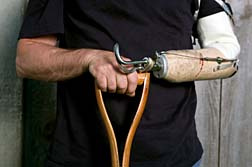 "Here's the deal. Once upon a time, when you had surgery on your shoulder, you might have been given oral pain medication to take while the wounds, both outside and inside the skin were healing. However it's hard to target one, specific area of the human body, with oral pain medication.
"Here's the deal. Once upon a time, when you had surgery on your shoulder, you might have been given oral pain medication to take while the wounds, both outside and inside the skin were healing. However it's hard to target one, specific area of the human body, with oral pain medication.Shoulder pain pumps came along in the 1990's. A small device, strapped to a patient's arm or waist, would deliver sustained levels of pain medication via a catheter inserted into the muscle adjacent to the surgical site, or in the general surgical area. This delivering of pain medication directly to the surgical site was a vast improvement over oral drugs, and was embraced by the medical community.
Subsequent to that, someone had the bright idea that delivering pain medication directly into the cartilage of the shoulder after shoulder surgery was a further improvement, and resulted in the ultimate pain relief for a patient recently undergoing shoulder surgery.
Did it work? Sure. Pain relief was great. It's what happened after the fact that has cost a lot of people the use of their shoulders. Others have undergone multiple shoulder surgeries.
There have been reports of amputations, stemming from a shoulder injury successfully repaired, initially, through surgery.
Why? A condition known as postarthroscopic glenohumeral chondrolysis (PAGCL), which results in the degeneration of the cartilage in the shoulder, between the arm and the shoulder itself. The culprit is the intra-articular post-operative pain pump, and the pain medication it delivers directly to the cartilage.
Pain medication is toxic to the cartilage. Thus, precious cartilage breaks down—and as cartilage does not regenerate and re-grow once it is gone, it's gone. That's it.
Suddenly, a surgical procedure meant to correct an injury or some other surgical problem, has instead led to a more significant problem that could have life-long consequences.
There is no cure for PAGCL. The only response is to replace the shoulder.
Imagine if this happens to a person early in life. In order to maintain mobility throughout their lifetime, a young PAGCL patient who may have suffered a shoulder injury playing sports (a common occurrence) could face multiple shoulder replacements, given that shoulder replacements have a fairly narrow life span. In extreme cases a shoulder may have to be fused altogether, robbing a patient of the use of their arm—and yes, there have been reports of amputations.
Imagine such a thing happening to a vibrant, active person relatively young in life. An injury slowed them down. Surgery fixed them up. But then the pain pump did them in.
READ MORE SHOULDER PAIN PUMP LEGAL NEWS
However, doctors have the authority to prescribe drugs, or use medical devices off-label, and one can certainly understand their enthusiasm given glowing reports from patients who reported pain levels significantly lower than normal.
Sadly, the gain has been short-lived—and there are literally hundreds, if not thousands of patients now facing a lifetime of stress, immobility and even disability thanks to the use of the shoulder pain pump.
The shoulder injury got them to the hospital. The shoulder surgery restored their mobility. But the shoulder pain pump caused their disability.
If you see yourself here—call a lawyer.
